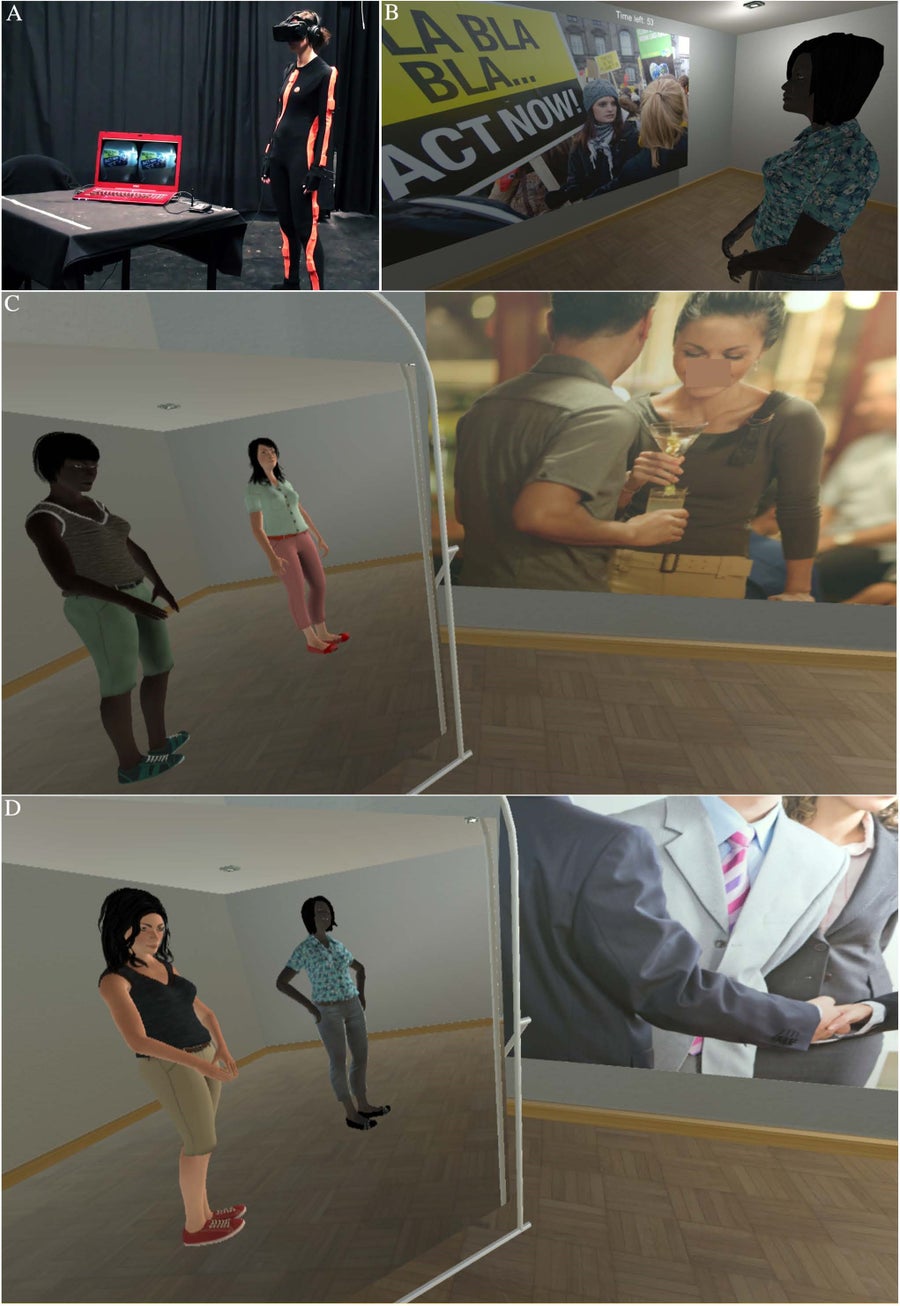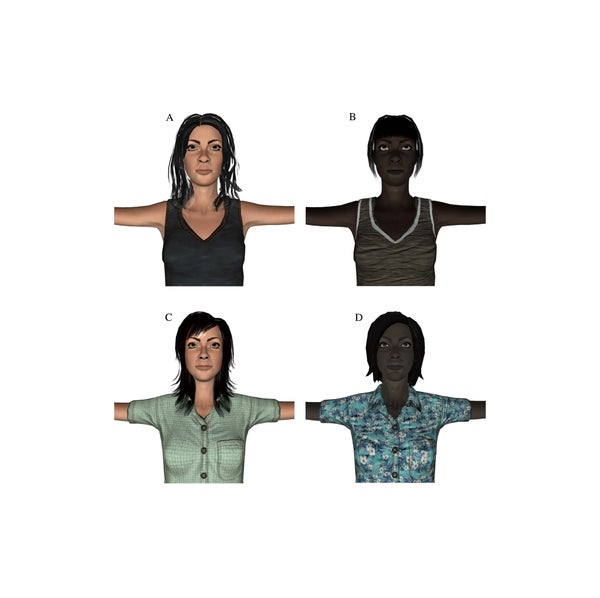This article was published in Scientific American’s former blog network and reflects the views of the author, not necessarily those of Scientific American
A team of scientists has used full-body immersive virtual reality to dive deep into some of the potential contributors to racial bias. Beatrice S. Hasler, Bernhard Spanlang, and Mel Slater (affiliated with the Sammy Ofer School of Communications of Israel, the University of Barcelona and ICREA in Spain, and University College London in the UK) conducted a study that assigned two different VR bodies to each participant, one black and one white, to see how skin color affected their behavior. That’s a remarkable statement if you read it back slowly, so let’s first unpack its meaning.
The fundamental role of VR is to make you feel present in a place where you aren’t. This illusion—presence—is powerful and somewhat perplexing. How can I feel like I’m somewhere else just by watching a TV show? The answer to this lies in how consciousness is born in the brain.
Think about the place you are in right now. How much do you know about it? You’ve used your sensory systems to collect information about the surfaces of objects around you: you may have looked at the ground, the walls and ceiling if there are any, furniture or other nearby objects. But how much detail did you sample from these surfaces? The answer is: not much.
On supporting science journalism
If you're enjoying this article, consider supporting our award-winning journalism by subscribing. By purchasing a subscription you are helping to ensure the future of impactful stories about the discoveries and ideas shaping our world today.
Your visual system, for example, is your richest sense, but its ability to collect data about the real world is bad. If you hold your thumb out at arm’s length and look at it, the area of your visual field in which you see well is about the size of your thumbnail. That’s about 0.1% (1/1000) of your entire visual field. Everywhere else you are legally blind. You see so very little in high resolution that you must make eye movements to jump this valuable piece of real estate (your central vision) around the world, just to understand your environment. And you only make one to three eye movements each second. So, it follows that when you walked into your bedroom last night to sleep, you made about 10 or fewer eye movements in the three seconds it took you to get from the door to the bed. You thus saw less than 1% of your bedroom with high-quality vision. But you didn’t fall. You didn’t walk into the wall. Your head hit the pillow on target and not the foot of the bed. How is this feat possible given how little you could actually see?
The answer is that your brain invents other 99% of the world, continuously and in real-time throughout your entire life, based on your models and presumptions about the world. That’s what consciousness is: it’s a simulation of reality created by our brains, which makes us feel like we know where we are. Your brain is so good at making stuff up that it can do it with VR gear instead of reality. Or by watching a movie or TV. Or by listening to a radio narrative. Or even by reading a book. Your imagination bestows you with the ability to consciously become aware of objects and sensations that don’t truly exist. That’s what your imagination is for—from a biologist’s evolutionary perspective. As critical a part of the visual system as the lens of your eye.
That’s how VR can be so immersive, despite that it is literally created by holding a phone camera to your face and viewing it through a pair of thick spectacles: that’s more-or-less as much information as we get from reality anyway. The world is so complex that your brain must take shortcuts to get the hard work of surviving done before you starve to death. It must make fast decisions on little data, relying on probability to make decisions about how you live. Because of this, it is a statistical certainty that some of your brain’s presumptions are wrong at least some of the time. In a perfect word, we would not trust them at all: but the veridical world, alas, is truly virtual, in its reality.
All of this means that VR can be used not just for entertainment to turn you into Wonder Woman of the Justice League, or Luke Skywalker in a galaxy far, far away. It can also help conduct some pretty cool and very well-controlled scientific experiments that would not be possible in the real world, such as change your race and see how you react.
In this experiment, the Slater Lab used all white participants, who wore VR motion-capture suits that tracked their full body motion in real-time. These suits don’t cause skin sensations on the participants, but instead, allowed the computer to follow their body posture so that their computer avatars trailed precisely. This method reportedly creates the strong feeling of presence within a virtual body. The scientists put the participants in an environment where they interacted with an avatar interlocutor while they both stood in front of a wall-sized mirror. So the participants could see themselves and their partner as they moved in real life, which further heightened the feeling of presence.
Participants unconsciously mimicked the body posture of their interlocutors, but did so more when they shared the same race. What is especially interesting is that the true race of the participant did not matter: it’s as if they felt akin to their partner when they shared the same skin, even thoug they had been a different race for their entire life.

Panel A: A participant in her full-body motion capture suit and VR headset. Panel B: the participant from Panel A’s virtual experience. Panel C and D: The participant interacts with a virtual character in a VR world while scientists analyze her body and mimickry behaviors. Credit: Mel Slater
Previous studies had pursued questions of race, mostly using questionnaires and the veritable Implicit Association Test (in which the reaction time to questions is used to quantify the level of cognitive dissonance participants experience between pairs of potentially racially-charged ideas). But these previous tests are subject to experimental difficulties because participants can attempt to modify their answers if they realize what the test is about. A major advantage to this new paradigm is that mimickry is unconscious, and the participant can be performing some unrelated task during the experiment.
The findings indicate that we use our congruency with people around us to determine whether we are members of the same group. We identify more with, and are more likely to feel like we can trust, people in our “in-group” than in the “out-group.” In-groups and out-groups are not determined solely by race, and friendships can break down race and social barriers, allowing us to bring each other into the fold irrespective of skin-deep differences or similarities. The importance of this study is that it shows that how we see others in relation to ourselves affects our behavior automatically, unconsciously, and above all, unreasonably.
